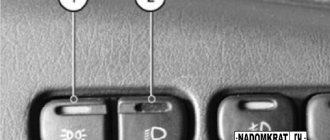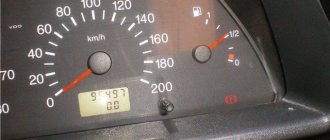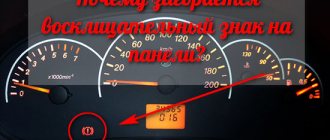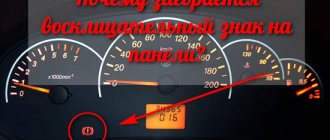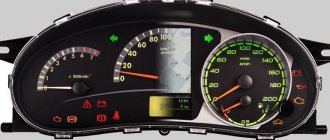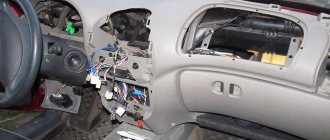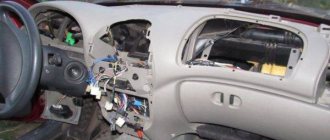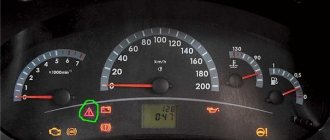What does the exclamation mark mean?
The illumination of a red exclamation mark on the instrument panel informs the driver that the fluid level in the brake system is insufficient. When this sign lights up on the instrument panel, it is necessary to stop the car as quickly as possible, check the level of brake fluid in the reservoir, as well as the brake line for leaks.
The fluid level should be between the minimum and maximum marks; if there is not enough liquid in the tank, it must be added.
If, during inspection, leaks of brake fluid are found from the fittings of hoses and tubes or other connections, it is prohibited to continue driving.
Prerequisites for the appearance of the icon
Most often, the reason for a malfunction of the car's brake system is a drop in the level of brake water. For this reason, on some cars the “exclamation mark” icon may “blink”, depending on the driving conditions (the brake fluid splashes in the reservoir, which is why its level becomes lower or higher).
The water level can drop for several reasons, for example: due to a water leak, due to severe wear of the brake pads, or due to evaporation during long-term operation without replacement (according to regulations, water changes must be performed at least once every two years ).
Another prerequisite for the appearance of the icon may be a significant decrease in pressure in the brake system, which is created by the vacuum brake booster. In this case, diagnostics is needed (the process of establishing a diagnosis, that is, a conclusion about the nature of the disease and the patient’s condition)
vacuum booster.
The icon on the device panel may also light up if the defect notification system itself is damaged. In other words, if the brake system sensor stops working, it reports this to the driver.
A prerequisite for the appearance of the “exclamation mark” icon can also be a malfunction of the hand brake - the parking brake system of the vehicle. For example, the handbrake position sensor may not work correctly, or the handbrake itself may not be completely turned off.
It is worth saying that almost all modern cars have an integrated computer with immense capabilities, among which, in addition to the options for car functions and multimedia system control, there is also an express diagnostics section, which displays information about the condition of the car. If any icon appears on the device panel, it would be a good idea for the driver to look into this section, where you can find out more thoroughly about the dilemma.
Why may TJ levels decrease?
The reasons for the decrease in level may be the following factors:
Brake fluid leak
This problem can occur after driving on deep snow or gravel roads, where brake line tubes and hoses are at risk of damage. Leaks are also possible at the connections of the calipers and the main brake cylinder.
Pad wear
When the pads are worn out, the caliper piston comes out of the seat much more than with new pads, therefore, the volume of fluid required to fill the space increases, and the fluid level in the reservoir drops.
When replacing the pads with new ones, the level should be restored to normal.
Damage to the fuel level sensor
This reason occurs quite often. The cap of the brake fluid reservoir contains a sensor that measures the fluid level; when it drops, the contacts on the sensor close and the lamp on the instrument panel lights up in the form of a red exclamation mark, informing that the brake fluid level is low.
Quite often it happens that the fuel fluid level is within acceptable ranges, but the indicator still lights up, this indicates a malfunction of the level sensor or its power circuit.
What to do if the icon appears
The first thing the driver needs to do when the “exclamation mark” icon appears is to postpone his trip (or brake if the icon appears while driving).
Then you need to try to understand why the icon appeared. To do this you need:
- Go to the “car status information” section of the on-board computer (if there is one) and find there the reason for the appearance of the icon;
- Check the brake water level in the reservoir under the hood, add fluid as necessary;
- Check the connector of the brake water level sensor (remove and clean), it happens that dirt gets under the connector case or brake fluid fills it;
- Check the position of the handbrake and its limit switch, tighten and release the handbrake a couple of times;
- Check the condition of the brake pads (if the wheel rims allow this); excessive wear of the pads may be a prerequisite for low brake water levels;
- Check the operation of the brakes by pressing the pedal (if it is very soft or very hard, it is better not to drive the car again until the problem is eliminated);
- If you can’t find the cause of the “exclamation mark” icon without the help of others, it’s better to call a tow truck and take the car to a car service center, or try to find a good on-call diagnostician;
- If the nearest car service center is far away and there are no diagnostic specialists, you can try to read errors independently through the diagnostic connector of the car, through a special Bluetooth or Wi-fi adapter. For example, the ELM-327 adapter, which can be ordered with home delivery, is very comfortable and popular;
Checking the fuel oil level sensor
Checking it is quite simple; to do this, you need to unscrew the brake reservoir cap without disconnecting it from the connector. Then forcefully raise the “float”, then the lamp should go out; if this does not happen, then most likely the problem is in the sensor.
The next step is to check the control circuit. To do this, disconnect the sensor from the connector and insert a jumper into the plug, closing the two contacts together. When closed, the lamp should light up.
We hope our article was useful to you.
Warning
Of course, in this case, it is best to find the nearest service center to check the car's braking system. By the way, on the way to an unscheduled inspection, you need to be prepared for the fact that you will have to press the pedal harder if you need to brake. And also to the fact that the free play of the said pedal will increase, as will the braking distance of your car. By the way, if the icon lights up along with the ABS indicator, then when braking, premature locking of the rear wheels is possible.
Exclamation mark blinking on viburnum
Why is there a red triangle with an exclamation mark and a sign next to the battery?
- Large current consumption in the parking lot in Kalina - 2 answers
- Kalina dashboard is glitchy - 2 answers
- Fuel indicator needle goes off scale in Kalina - 1 answer
- Why doesn’t the needle light up on Kalina’s tachometer or speedometer? – 1 answer
- What does the EBD indicator on the dashboard mean? – 1 answer
Specifically, the transcript is written like this.
Warning lamp for malfunction of the electronic brake force distributor (connected as an option). The lamp lights up red when the ignition is turned on and goes out after 2 seconds (self-test mode). Further, this is my explanation, and if it is on, it means a malfunction of this system, and this is 100 percent true. Mikhail S. Well, he was right, but he was wrong about the level of brake fluid. But that's not the point. So this lamp, well, it refers to the ABS, but specifically speaks about the EBD system, in short, exchange rate stability. Do you have a car with abs and speed control? It happens that a Lada without abs but this lamp is present. But in such cases, it only works when the ignition is turned on and goes out. Well, if there is no abs, it will never burn constantly.
The triangle seems to be on the right - an emergency signal. On the left, where the battery sign is, a circle with an exclamation mark indicates a brake failure.
This icon lights up when the brake system is in an emergency condition. Check the brake fluid level, then carry out diagnostics with a scanner and check for errors in the ECU memory.
This icon actually stands for this:
The icon lights up along with a warning message on the instrument panel.
Is this situation with the engine running? Is the battery light also on? Is the check indicator on or off? In general, are there any problems with the operation of the engine and the behavior of the car?
Subscribe
to our channel in
Index.Zen
Even more useful tips in a convenient format
1) Hello. On my viburnum, a red exclamation mark in a circle lights up and goes out, sometimes it blinks, what is the reason.
Similar articles
18 comments on “Exclamation mark on the instrument panel of the VAZ Kalina. On my viburnum, a red exclamation mark in a circle lights up and goes out”
1. Malfunction in the brake system.
1 check the brake fluid level. I had this when I was ten
Most likely there is not enough brake fluid due to worn pads or a leak.
2 any after 3000 km change Castrol 5-40
1. The pads are worn out. Either the liquid has leaked or the sensor is faulty.
This is a “brake failure” indicator (indicator lamp for emergency condition of the service brake system). Take a closer look at the Operation Manual that came with the car, it says this there. The buzzer should still beeping. They correctly noted that this is probably a low level of brake fluid in the reservoir. Open the hood, apply brake fluid, look, maybe there is fluid leaking somewhere, maybe you need to tighten the connections. In general, this is bad; it’s better to deal with such a defect.
1 brake fluid level
2 do a break-in with inexpensive but not nasty oil like Lukoil. After 5 tkm we change with washing to another oil
2 after a thousand change the oil. Drive at least with mineral water
. Asks
: Smirnov Sergey.
The essence of the question
: An exclamation mark lit up on the instrument panel of the VAZ-2112, I don’t understand why?
Good afternoon I sometimes get an exclamation mark in a circle on my dashboard, most often this happens when braking! Please tell me what could be the reason and how to solve it?
Prerequisites for failure of the electric power steering on the Lada Kalina
For the first time, the Russian auto industry installed electric power steering on Kalina. At the first steps, he worked very erratically, right up to a complete shutdown. Later, they tried to remove the shortcomings, but the EUR remained a weak link and sometimes fails, as evidenced by the exclamation mark on the panel. This is evidenced by the feeling of a languid steering wheel, and it becomes difficult to turn with one hand.
The mechanism of operation of the electric booster is to reduce the force that must be applied when turning the steering wheel. The Kalina electric power steering control unit uses sensors to calculate the operation of the electric motor at the current speed and torque. Thus, giving a signal of the effort with which it is necessary to assist the driver when turning. After all, it does not work all the time and needs adjustment, which is carried out by the unit.
Why does the exclamation mark (!) light up on the instrument panel?
At the moment when the car brakes, the brake cylinders are pushed forward as much as possible, thereby acting on the pads. At this time, the cylinders are filled with the required amount of brake fluid in the system, and its level in the reservoir drops. It is for this reason that such an exclamation mark lights up
on the instrument panel, informing the driver about the minimum level of brake fluid in the reservoir, and accordingly in the system as a whole.
The following two tabs change content below.
All my life I have been surrounded by cars! First, in the village, already in the first grade, I was rushing around on a tractor through the fields, then there was JAVA, then a penny. Now I am a third-year student at the Polytechnic Faculty of Automotive Engineering. I work part-time as a car mechanic and help repair cars for all my friends.
Video with an overview of all warning lamps on the VAZ-2112
Reasons for appearance
If such an indication occurs, first of all we check the sensor itself
, which is located in the brake fluid reservoir. It is a float that actively interacts with the brake fluid.
When the float is dismantled, it must be put away on a rag.
In order to check its serviceability, it is necessary, with the engine running, remove it from the tank body and manually change the position of the float. If the indication on the instrument panel does not disappear and does not react in any way depending on the influence on it, then the sensor is faulty and needs to be replaced.
However, if the sensor is working properly, there may be a brake fluid leak.
Where might brake fluid leak?
It is very easy to find out whether the required level of brake fluid is in the system, since it can be seen visually through the brake fluid reservoir. Its level should always be closer to o
, and if it is significantly less, or its level has dropped, then a leak is possible.
Brake cylinder
The front brake cylinder is leaking
First of all, inspect the brake cylinders on all wheels for leaks.
As a rule, leaks most often occur on the rear drums due to their excessive overheating. It is not difficult to notice a leak on the cylinders, since in the case of the front cylinder, the leaks will be noticeable on the caliper, and on the rear, it can drip directly from the drum. Problems with these elements usually arise during the cold season.
Brake hoses
The brake hose has cracks.
It is also very easy to determine the presence of ruptures or cracks in brake hoses, since this is all visible to the naked eye. Most often, they crack at bends or due to friction with adjacent elements of the car body.
Master brake cylinder
Traces of brake fluid are clearly visible on the body.
When inspecting the brake master cylinder, inspect its external condition for visible leaks.
The main place where a rupture can occur is the rubber seal located closest to the vacuum booster.
Location of the vacuum brake booster and master cylinder
If a leak occurs, it will drip onto the gearbox housing, and then onto the CV joint on the left side. This is easy to notice, and only then proceed to replace it.
- If you find any of the above elements to be faulty, it must be replaced immediately. Since the operation of the car with such malfunctions is impossible.
- After replacing an element of the brake system, be sure to do so, since air will accumulate in the system during work.
For what other reasons might the lights on the dashboard start to light up?
According to experts, faults in electronics can also cause indexing. Icons may appear involuntarily on the dashboard due to the following breakdowns:
- if the contacts succumb to the oxidation process;
- if the terminals change their location;
- if breakdowns occur in the on-board car computer.
Taking into account the advice of experts, and in order not to harm one of the car systems, you need to check the functionality of electronic components. To do this, you will need to diagnose the electronic part, which is done quite easily - remove the dashboard and check the location of the terminals in the so-called sockets.
Understanding why the light on the dashboard lights up and finding out what kind of breakdown this or that sign indicates is quite simple if you familiarize yourself with each element located on the instrument panel.
Asks: Sergey Smirnov. The essence of the question: The exclamation mark on the instrument panel of the VAZ-2112 lit up, I don’t understand why?
Good afternoon I sometimes get an exclamation mark in a circle on my dashboard, most often this happens when braking! Please tell me what could be the reason and how to solve it?
At the moment when the car brakes, the brake cylinders are pushed forward as much as possible, thereby acting on the pads. At this time, the cylinders are filled with the required amount of brake fluid in the system, and its level in the reservoir drops. It is for this reason that a similar exclamation mark lights up on the instrument panel, informing the driver about the minimum level of brake fluid in the reservoir, and accordingly in the system as a whole.
The following two tabs change content below.
All my life I have been surrounded by cars! First, in the village, already in the first grade, I was rushing around on a tractor through the fields, then there was JAVA, then a penny. Now I am a third-year student at the Polytechnic Faculty of Automotive Engineering. I work part-time as a car mechanic and help repair cars for all my friends.
conclusions
Please note that replacing brake fluid is also necessary because, over time, it accumulates water particles from the air and becomes less effective.
With the development of the automotive industry, more modern instrument panels (DP) began to be used in vehicles. The software is used to inform the driver about the basic parameters of engine operation, as well as to warn about possible malfunctions in the operation of systems and components. What does the exclamation mark and other indicators mean? A description of the main icons is given below.
I checked everything - it didn’t help.
If you couldn’t independently determine the reason for the appearance of the icons, then it’s time to go for diagnostics, preferably to a good service center. For example, very inexpensive diagnostics in the VilGud car service network >>>
What should you do if a yellow exclamation mark lights up on your car's dashboard? This question often worries car owners. It is sometimes difficult to give an unambiguous answer to this, because in cars of different brands the same problems can be displayed on the display using different signs. This means that you will have to carefully understand them so as not to find yourself at some point in a hopeless, or rather, hopeless situation.
Information indicators
The lights on the dashboard can indicate failures in the operation of the engine and other systems, or be of an informational nature. In any case, the car owner must be able to decipher the “messages” transmitted by the control module in order to promptly fix the problem in the event of a breakdown. First, let's look at the description of information indicators.
| Icon | What does it mean |
| A yellow wrench in the background of the car indicates that the system has detected a malfunction in the engine. The EPC failure indicator may indicate problems with the sensors or controllers; sometimes the wrench icon appears when there is a malfunction in the electronic component of the transmission. Computer diagnostics of the car can tell you exactly what this error means. | |
| A red indicator in the form of a car with a lock usually lights up in the event of malfunctions in the operation of the anti-theft system, in particular, we are talking about a standard installation. In practice, such malfunctions are usually accompanied by the inability to start the power unit. If the indicator simply blinks when the car is locked and its security is activated, then there is no need to worry. | |
| The exclamation mark indicator can only appear in a car with a hybrid power unit; its appearance is due to problems with the operation of the electric drive device. When such an indicator appears, it is better to perform computer diagnostics - this option is the most relevant if you want to get accurate information about the breakdown. | |
| An icon in the form of a car with an open door may light up on the instrument panel if the ignition is turned on or the car engine is running and one of the doors is open. This can also apply to the trunk lid as well as the hood. If you checked the doors and are sure that they are all locked, then most likely the reason is inoperative limit switches that are installed on the doors or on the pillars between the door and the body. It may be that the electrical circuit connecting the limit switch is damaged. | |
| The ESP icon is a vehicle stability control sensor. The indicator may appear if the system has detected a slippery section of the road along which the car is moving. Activation of this unit is carried out to prevent wheel slipping by reducing the power of the power unit. In principle, the appearance of an icon does not threaten the car with anything bad, since the indicator itself is informational. However, if a yellow triangle, wrench or wear symbol lights up next to the light, then you need to worry about the performance of the system. | |
| The wrench symbol in yellow tells the driver that the vehicle is due for maintenance. You need to change the oil, check the filters, etc. When the maintenance is completed, the indicator can be reset by briefly disconnecting the battery terminals. |
Description of the Lada Priora and Kalina device panel
The composition of the Lada Priora/Kalina devices was created to display the features of movement, the current state of the vehicle's systems, ensuring the safety of movement, as well as the correct operation of the entire vehicle as a whole. If you are a novice driver, then this description of the dashboard will help you understand the readings of devices and indicators.
- Tachometer. Indicates the engine speed in real time. The reddish color of the scale means that the operating mode is terrible for the motor;
- Malfunction lamp of the electric brake force distributor. To check, the lamp lights up reddish for a few seconds when the ignition is turned on. The burning of the lamp in other cases indicates a malfunction; when driving with a flaming lamp, it is necessary to observe excessive safety measures;
- Battery charge lamp. To check, the lamp lights up reddish when the ignition is turned on and goes out after the engine starts. The burning of the lamp in other options indicates a lack of battery charge;
- Left turn signal lamp. Flashes when the turn signal or hazard warning lights are on;
- Speedometer. Indicates at what speed the car is moving at this moment;
- Engine oil pressure warning lamp. To check, the lamp lights up when the ignition is turned on and goes out after the engine starts. The burning of the lamp in other versions indicates low pressure in the engine lubrication system. It is not recommended to operate the engine in such conditions;
- Right turn signal lamp. Flashes when the turn signal or hazard warning lights are on;
- Handbrake lamp. Lights up with a reddish light when the 100-speed brake is applied;
- Cooling water thermometer. The operating temperature of the motor is 90 degrees and above to the reddish zone. It is prohibited to operate the vehicle if it overheats. When the arrow reaches the reddish zone, a buzzer will sound. To extend the service life of the motor, it is recommended not to operate the engine at high speeds until the cooling water temperature reaches operating temperature;
- Gasoline level indicator in the tank. The arrow indicates the fuel level. Lack of gasoline can damage the fuel pump;
- Fuel reserve lamp. Lights up with a accompanying buzzer signal when less than 10 liters of fuel remains in the tank;
- Key for switching display modes and resetting daily mileage readings. A short press switches between daily and total mileage. When you hold down the key, the daily mileage is reset, followed by a sound;
- Hazard warning light. It flashes with a reddish light when the emergency lights are turned on together with the turn signals.
- Fault lamp of the electric power steering (EUR). To check, the lamp lights up yellowish when the ignition is turned on for a few seconds. Lighting of the lamp in other variants indicates a malfunction of the EUR;
- Lamp for turning on high beam headlights. Lights up when the headlights are turned on;
- Lamp for turning on external lighting. Lights up when the headlights are turned on or the headlights are turned on;
- Airbag system malfunction lamp. To check, the lamp lights up with a yellowish light when the ignition is turned on for a few seconds. The burning of the lamp in other versions indicates a malfunction in the airbag system. In this case, in case of an accident (Road accident (car accident, car accident) - an event that occurred during the movement of a vehicle on the road and with its participation, in which people were killed or injured, vehicles, structures, cargo were damaged, or other material damage was caused damage)
the safety pads will not work; - Immobilizer lamp. If the system is working properly and the engine is allowed to start, when the ignition is turned on, the lamp flashes once and goes out. If the lamp flashes constantly (accompanied by small buzzer signals), the system is faulty. If after turning on the ignition the lamp glows for 15 seconds and goes out, the anti-theft system is not activated;
- Liquid crystal display of the on-board computer (BC). Displays daily and total mileage, as well as information from the BC;
- Seat belt warning light (function). The lamp lights up when the driver's seat belt is not fastened, accompanied by buzzer signals for 1.5 minutes;
- Brake system emergency lamp. To check, the lamp lights up red when the ignition is turned on for 4 seconds. In other options, the lamp’s lighting indicates an insufficient level of brake water, or another malfunction of the brake system;
- Front passenger safety cushion lamp (function). Passenger airbag deactivation lamp;
- Anti-lock braking system malfunction lamp (function). To check, the lamp lights up when the ignition is turned on and goes out after a few seconds or after the engine starts. If the lamp is on, it means there is a malfunction in the ABS system, but the brakes remain 100% functional;
- Engine control system malfunction lamp (Check Engine). To check, it lights up when the ignition is turned on and goes out after the engine starts. In other options, the lamp is lit indicating a malfunction in the system. See the error code.
Warning symbols on the visor
Now we suggest you familiarize yourself with the warning indicators on the tidy. Let's consider only the most common symbols (video published by Kirill Mukhin).
| A yellow steering wheel symbol indicates that the steering system needs to be adapted. If this indicator lights up red, then you should diagnose the performance of the amplifier, which can be electric or hydraulic. |
| The key sign in the background of the car usually flashes after the car has been armed. If the lamp is on without blinking, this indicates possible problems that have occurred in the operation of the system. Typically, the appearance of the symbol is due to the fact that the anti-theft system mechanism cannot read the tag from the key or that the installation has not turned on. |
| The handbrake icon is always on when the handbrake lever is raised, as well as when there is a malfunction, in particular, wear on the brake pads. Sometimes this symbol appears when it is necessary to add brake fluid to the expansion tank. If the pads are intact, the fluid level is normal, and the indicator lights up when the lever is released, then most likely you need to change the brake fluid level sensor; it is located in the fluid reservoir. |
| The yellow coolant symbol indicates the need to add consumables to the reservoir. The indicator may light up if the sensor or float in the expansion tank breaks down, and if it lights up red, then the power unit may have overheated. Before adding antifreeze, you need to eliminate the cause of its leak, and also make sure that the engine is not overheated. |
| The washer system symbol appears when there is insufficient washer fluid or water level in the tank; in some cases, the cause is a clogged level sensor. In more modern cars, the icon may appear if the fluid used does not match. |
| Traction control indicator. If the symbol lights up continuously after starting the engine, then there is apparently a problem with the system. The indicator itself may look different, it all depends on the car. |
| This is the catalyst icon; it usually lights up after the unit has been overheated. A related symptom is a lack of engine power. The cause of overheating may be poor throughput of the catalyst cells or problems with the ignition system. If the catalyst fails, the fuel consumption should also increase. |
| Such a lamp indicates that a problem has occurred in the exhaust gas purification system. In practice, this light most often appears after the car has been filled with low-quality fuel. The reason may also be due to the inoperability of the lambda probe. |
Photo gallery “Dashboards of different cars”
1. Tuned PP in VAZ 2109
Reasons for shutdown
The main reason lies in the electric power steering. When ignited, the system performs a self-diagnosis and if the mechanism does not pass it, a signal is turned on indicating a malfunction. The color of the signal indicates the degree of danger. The light turns red, the problem needs to be fixed urgently. If the color is yellow, the vehicle can be operated, but safety precautions should be taken. There may be several reasons why the electric power steering on Kalina does not work:
- speed sensor malfunction;
- torque sensor malfunction;
- speed exceeds 60 km/h;
- engine speed is less than 400 per minute;
- failure in the control unit;
- poorly soldered contacts;
- insufficient tension.
Software shutdown
- The electric power steering on Kalina turns off after 60 km/h. Therefore, keep this point in mind; it is set in the system unit and is not a breakdown. The Priora's electric power steering is switched off at a speed of 110 km/h.
- Also, the EUR does not work at low engine speeds. If the value is less than 400 rpm, it is not active.
This is software planned inactivity. It is needed to give information to the steering wheel at high speed and reduce wear of the mechanism.
Electrical booster malfunctions
In the event that it is impossible to immediately check the cause of failure of the electric power steering on Kalina, you need to remove the fuse from the block. This is necessary to prevent sudden activation of the mechanism, which leads to emergency situations.
Lights indicating a malfunction
Now let's look at the indicators that indicate problems.
| The red battery symbol lights up on the control panel if there is no battery charge from the generator unit. In the case of hybrid cars, the appearance of such a light will be accompanied by the inscription Main. |
| A lamp in the form of an oil can informs the driver that there is a lack of motor fluid in the power unit. The symbol always appears when the ignition is activated and disappears after the engine is started. If the indicator lights up after starting the internal combustion engine, then you need to check the oil level in the engine, all leaks must be eliminated. |
| Malfunction of the airbags. You need airbags; if an emergency or collision occurs, then most likely the airbags will not deploy. |
| This symbol can be made in different variations. If the color of its glow is red, then there are malfunctions in the functioning of the brake system, so the system must be checked before driving. The lamp may come on as a result of a lack of brake fluid in the reservoir or worn out pads. It is possible that the reason for the appearance of the lamp is due to a sensor failure. |
| The on-board computer detected malfunctions in the functioning of the ABS. If there is ice on the roads, then the problems must be corrected, since such driving can be very dangerous. The brake will function, but the ABS system will not work. |
| The Check Engine light comes on when the electronic control unit detects a malfunction in the operation of the power unit. There can be a huge number of reasons in this case, so you need to do computer diagnostics. |
| Faulty glow plugs - this symbol is only available in diesel vehicles. If the light is constantly on, you need to check the ignition system. |
If you are faced with a problem with the dashboard not working, then the video below will allow you to familiarize yourself with the repair process using the example of a Volkswagen car (the video was filmed by the altevaa TV channel).
Hi all! Today I want to raise a rather current topic that, judging by the questions on the forums and the number of requests in search engines, worries a large number of people. I want to talk about a phenomenon where when you press the brake pedal, an exclamation mark on the dashboard lights up.
I will try to give a comprehensive answer to this question and explain why this happens and what kind of damage may be involved. Go!
Let me start, perhaps, with the fact that if a lamp (!) lights up on the panel, it means something is wrong with the brake system. As a rule, this indicator signals a low level of brake fluid (BF) in the system. As you can imagine, faulty brakes are no joke and the problem needs to be addressed. I’ll say more, if anyone doesn’t know, OPERATING A CAR WITH A BURNING INDICATOR (!) IS PROHIBITED!
Since you don’t know what’s wrong and what caused this error to appear on the dashboard.
Fuse box
The weak link of the electric power steering on Kalina is the fuse box; if something doesn’t work, it’s worth checking them.
To get to them, you need to open the dashboard, to the left of the steering wheel. To do this, pull the top part towards you and the latch will open. Check if the fuse is working, if it fails, replace it. It is very easy to check, check the integrity of the thread inside the fuse. Changing a 50 amp relay to a 30 amp one will also help.
Newer versions of Kalina are equipped with electric amplifiers from Hyundai, which has a positive effect on its reliability. However, there are still thousands of cars with the domestic version, which malfunctions and breaks down from time to time. Now it will be easier for you to repair the electric power steering on Kalina yourself. The main thing to remember is that not every amplifier shutdown is a breakdown. And you can find the problem yourself and fix it, but somewhere you will have to go to a service center.

